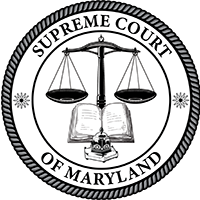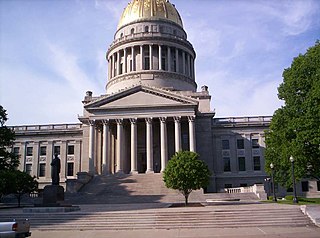The government of the U.S. state of Missouri is organized into the state government and local government, including county government, and city and municipal government.

The Supreme Court of Maryland is the highest court of the U.S. state of Maryland. The court, which is composed of one chief justice and six associate justices, meets in the Robert C. Murphy Courts of Appeal Building in the state capital, Annapolis. The term of the Court begins the second Monday of September. The Court is unique among American courts in that the justices wear red robes.

Speculation abounded over potential nominations to the Supreme Court of the United States by President George W. Bush since before his presidency.
The Midnight Judges Act expanded the federal judiciary of the United States. The act was supported by the John Adams administration and the Federalist Party. Passage of the act has been described as "the last major policy achievement of the Federalists."

The Michigan Supreme Court is the highest court in the U.S. state of Michigan. It is Michigan's court of last resort and consists of seven justices. The Court is located in the Michigan Hall of Justice at 925 Ottawa Street in Lansing, the state capital.

The Indiana Supreme Court, established by Article 7 of the Indiana Constitution, is the highest judicial authority in the state of Indiana. Located in Indianapolis, the Court's chambers are in the north wing of the Indiana Statehouse.

The Supreme Court of Texas is the court of last resort for civil matters in the U.S. state of Texas. A different court, the Texas Court of Criminal Appeals, is the court of last resort in criminal matters.

The Supreme Court of Oklahoma is a court of appeal for non-criminal cases, one of the two highest judicial bodies in the U.S. state of Oklahoma, and leads the judiciary of Oklahoma, the judicial branch of the government of Oklahoma.

The Supreme Court of Georgia is the highest judicial authority of the U.S. state of Georgia. The court was established in 1845 as a three-member panel, increased in number to six, then to seven in 1945, and finally to nine in 2017. Since 1896, the justices have been elected by the people of the state. The justices are currently elected in statewide non-partisan elections for six-year terms, with any vacancies filled through an appointment by the Governor.

The Supreme Court of Alabama is the highest court in the state of Alabama. The court consists of a chief justice and eight associate justices. Each justice is elected in partisan elections for staggered six-year terms. The Supreme Court is housed in the Heflin-Torbert Judicial Building in downtown Montgomery, Alabama.

The Supreme Court of Arkansas is the highest court in the state judiciary of Arkansas. It has ultimate and largely discretionary appellate jurisdiction over all state court cases that involve a point of state law, and original jurisdiction over a narrow range of cases. The Supreme Court holds the power of judicial review, the ability to invalidate a statute for violating a provision of the Arkansas Constitution. It is also able to strike down gubernatorial directives for violating either the Constitution or statutory law. However, it may act only within the context of a case in an area of law over which it has jurisdiction.

The Montana Supreme Court is the highest court of the state court system in the U.S. state of Montana. It is established and its powers defined by Article VII of the 1972 Montana Constitution. It is primarily an appellate court which reviews civil and criminal decisions of Montana's trial courts of general jurisdiction and certain specialized legislative courts, only having original jurisdiction in a limited number of actions. The court's Chief Justice and six Associate Justices are elected by non-partisan, popular elections. The Montana Supreme Court meets in the Joseph P. Mazurek Building in Helena, Montana, the state's capital, an international style building completed in 1982 and named in the honor of former Montana Attorney General, Joseph P. Mazurek.

As established and defined by the Kentucky Constitution, the government of the Commonwealth of Kentucky is composed of three branches: the Executive, Judicial, and Legislative.

The Government of West Virginia is modeled after the Government of the United States, with three branches: the executive, consisting of the Governor of West Virginia and the other elected constitutional officers; the legislative, consisting of the West Virginia Legislature which includes the Senate and the House of Delegates; and the judicial, consisting of the West Virginia Supreme Court of Appeals and lower courts.
Sharon Lee Kennedy is an American jurist who has served as chief justice of the Ohio Supreme Court since 2023. She was first elected to the court as an associate justice in 2012 after serving as a judge of the Butler County Court of Common Pleas from 1999 to 2012.

Leonard J. Stern was a Republican lawyer from Ohio who served as a Common Pleas judge, an appeals court judge and from 1970 to 1977 was a justice of the Ohio Supreme Court.

The Ohio general elections, 2016 were held on November 8, 2016 throughout Ohio. The close of registration for electors in the primary election was December 16, 2015, and the primary election took place on March 15, 2016.
In Pennsylvania, the judiciary is chosen through partisan elections. Partisan elections involve judges political party to be listed on the ballot. The Commonwealth of Pennsylvania has not always elected judges through this process.
John A. Hutchison is an American lawyer serving as a justice of the Supreme Court of Appeals of West Virginia. He joined the court in 2018 and served as chief justice in 2022.

The 2020 Ohio general elections were held on November 3, 2020 throughout the US state of Ohio. The office of the Ohio Secretary of State oversees the election process, including voting and vote counting.

















